Tom recently became a member of NWSSA and he attended his first Camp Brotherhood Symposium in 2001. As he points out, he found a welcome home in our organization where his considerable training and experience in the arts can blossom. His slide show of his work that he showed at Camp B. was most impressive, and now we can learn more about the man behind the art.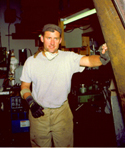
LE: What is your life history as it relates to being an artist?
TS: When I look back on my life history, I can’t imagine being anything else but an artist. My parents are both very creative. My father was always building our house around us and drawing as an architect and my mother was a piano teacher. I started carving wood when I was seven or eight years old. I was exposed to Native American art, contemporary art (Picasso, etc.) and Renaissance art (Leonardo, Michelangelo) at an early age.
In high school I began to carve wood more seriously, doing representational work, and started to feel good about doing that in a world where I was totally socially inept.
In college, art classes were the most fun and I moved towards foundry arts – welding and bronze casting. I think I was drawn by the chance to work big scale with big tools. Towards the end of my time at the U.W., I was very lucky to get to study the Native American Arts of our Northwest Coast with Duane Pasco and Bill Holm. I did a lot of two-dimensional graphics and wood carving then. Those form-line relationships really became ingrained in my brain.
After graduating in 1984, I moved to a remote location in the Olympic Mountains where I was a caretaker for four and one-half years. There I worked on developing my own ideas and style and started carving small basins out of hard lenticular-shaped stones taken from the river I lived next to. I also made two trips to New York City where I visited as many galleries as possible.
I moved to the San Juans in 1989 where I had started showing art in the local gallery – Wonderworks. Over time I found myself carving stone more than working with wood or metals. I worked mainly with granite boulders from local fields and beaches. A contractor supplier turned me onto a diamond blade and I was hooked. Three or four years ago I became dissatisfied with my understanding of stone. I began looking around and found Tracy Powell and Brian Berman. Thus began my ineluctable slide into the NWSSA.
LE: How has the NWSSA influenced your work as an artist?
TS: The strongest thing I feel coming out of the NWSSA/Camp Brotherhood experience is the sense of affirmation in the work I am doing. It helps to know we are not on that creative path alone. It’s hard to hold that passion for stone all to ourselves.
The technical support has been great – tool junkie you bet! I enjoyed the exposure to so many new ideas and perspectives on stone. Lately my mind and sketchbooks have overflowed with ideas and new ways to approach stone, and I’m sure that Camp Brotherhood was a catalyst in that. When I left Camp Brotherhood I found myself thinking more about all the people I had met and the stone was secondary as some malleable substance we all joined our hands in to connect energies.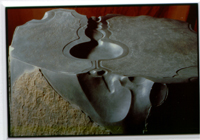
LE: How does your art reflect your philosophy?
TS: My philosophy is that Mother Nature is our best teacher, human arts of creation are good, and there is no philosophy or religion or science that can grasp the vast mystery of the existence of the universe.
I have just learned a new Sanskrit word – Acanda; it means that joy in existence without which the universe will fall apart and collapse. I try to express the vibrancy and subtlety and newness I find in nature. I try to create harmony and stimulation simultaneously. I try to maintain my story in my work and create pieces that show joy in their creation.
LE: What is your source of inspiration?
TS: My inspiration can be found in my philosophy. I can’t think of any natural objects that are not great teachers of form. Lately I have been studying bones, seedpods, leaves, clouds, and astronomy. Magic is a constant solace and inspiration for me. I often get sparks of inspiration from other artists’ work. I am inspired by the process of exploration. I am pulled by the desire to see what’s around the next bend. The moments when your vision on the stone glows in a new way or your technique pushes on to new levels are some of the best rewards and inspirations. There are pieces by Isamu Noguchi that represent for me great meeting places of the essence of stone, the pulse of the universe, and what the artist can bring to the stone. Noguchi’s hand is powerful and heavy in the stone but somehow the stone is able to have its full and honest energy. That’s inspirational.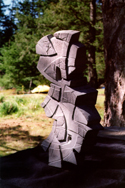
LE: How do you develop your ideas?
TS: I work out ideas primarily by drawing on the stones, then carving, then drawing, etc., etc. I come to stones with preconceptions and sketches but the carving experience dominates. I often do quick line drawings to explore and test out ideas. Lately I have been doing drawings where the pen strokes begin to represent the marks of the diamond blade and on the stones the diamond blade marks become pen strokes. It is a dynamic approach and the two processes are assisting each other towards idea evolution.
As a fuel to keep my ideas growing, I have been using the metaphor of a small fire inside me that I must keep feeding regularly. The fire represents the energy of new creation.
LE: What stones do you prefer?
TS: Usually my favorite stone is the one I’m working on.
LE: What tools do you use?
TS: Most of them. Angle grinders are the workhorses but also capable of great expression. Air hammers and chisels are always fun tools for me and fairly infinite in their ability to create different surfaces and do fine detail. I love slowing my perception down to hard chiseling and getting into that intimacy. Recently I was roughing out a five-foot tall granite column with angle grinders and having a hard time finding the gesture and lines of the piece, so I switched to my biggest air hammer and bushing tools. The energy and pace of air chiseling allowed me to perceive the work differently and find the gesture. Sometimes chisels have their own ideas about what they want to do.
LE: Do you teach art?
TS: I have done a little teaching with high school kids as a guest artist and substitute teacher. I like it when they plug in and get absorbed by the work. I’m going to start teaching adults now, though I’m not sure how. It seems that art is a very mystical process once you get beyond tools and materials. How does one nurture fascination and inspiration? [Ed. Note: Come see for yourself how Tom teaches adults. Come to Silver Falls Symposium where Tom will be an instructor.]
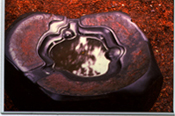
LE: What have been your satisfactions in your life as an artist?
TS: My biggest satisfactions have been when people connect with my pieces. It’s nice to know that our vision is shared and we haven’t been blowing dust on some obscure fantasy. I had a lot of fun with “Love Seat”. It was a beautiful rock to start with and it was artistically challenging, and when I placed it in public spaces, people really enjoyed sitting on it and being with it.
One of my favorite rewards has been found at home alone in my studio when I have taken a piece around that corner into the space where it is alive and it works. This is especially rewarding with pieces that pushed me into new territory, and yet the piece moved closer to my inner vision. “Jazz Fragment” feels like that kind of piece. That process almost sounds selfish but I believe it can take us to our gods and goddesses and from that meeting we can bring back the best energy we can share.
LE: What are you looking forward to?
TS: More carving, more pursuit of visions and fantasies, more time with my stone carving friends, more technique, more big pieces, more opportunities for public and community art, and staying healthy.
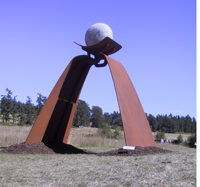
LE: Finally, I just want to say...
TS: Thanks to NWSSA for being such a stone carving oasis/haven/church. See you at Camp Brotherhood and Silver Falls.

